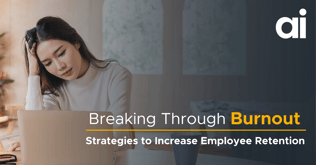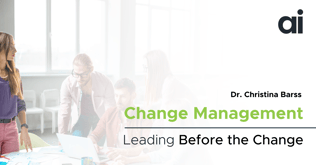Blog
Breaking Through Burnout: Strategies to Increase Employee Retention
Are you challenged with fostering a sense of community and inclusion in your hybrid work environments? If your answer is no, you may be in for a ...


How to Give Your Employees a Seat at the Table with Design Thinking
By Allen Interactions | November 21, 2022 | Change Management | 0 Comments
Are you challenged with fostering a sense of community and inclusion in your hybrid work environments? If your answer is no, you may be in for a shock. Over half of employees globally are victims of quiet quitting, which is taking a significant toll on employee morale and company culture. With dispersed workforces, employee engagement is more important than ever and is changing the overall relationship that we have with our teams.
In this blog, we will unpack the high price of low employee engagement - helping you create that compelling case for change. We will then outline different tactics to amplify your employee's voices and give them a sense of belonging which leads to an improved employee journey.
The high price of low employee engagement
Employee engagement is defined as “the basic psychological needs that must be met in order to perform your job well, including emotional and social needs and connecting your work with a higher purpose.” Why is engagement so important? Consider this: many of us spend a third of our lives within our digital or physical workplaces. Positive or negative, our workplace culture can have a significant impact on our employees - and our bottom line.
By the numbers:
- Gallup reports only 21% of employees globally feel engaged at work
- Low employee engagement costs organizations roughly 450-500 billion dollars annually
- Companies with highly engaged employees are over 20% more profitable than their counterparts
- Highly engaged organizations score nearly 20% higher in productivity
- An engaged, thriving company culture can yield enormous revenue results - 682% in a major long-term study.
Understanding the employee journey
A key to sustainable change for improved employee engagement is looking at it from a strategic viewpoint: the employee journey. The employee journey describes what your team members experience throughout the traditional life cycle. Employee engagement begins at talent acquisition - at the recruitment stage and then continues beyond their departure.
Employee engagement is built on a foundation of relationships, trust, and advocacy throughout seven stages. Gallup defines the employee life cycle through areas that encompass the most important employer-employee interactions, which create a bond with the company. Of the seven stages, engagement, performance, and development are connected to the daily performance and actions of our teams.
.png?width=700&height=366&name=Services%20-%202022%20Blog%20Covers%20and%20In-Line%20Graphics%20(1).png)
- Attract: The discovery phase for both employers and candidates. Within this stage, marketing becomes an important influence in conveying your organization’s mission, messaging, and targeting ideal team members. Does your job description accurately reflect the expectations of the role, your values, and your respect toward employees? The success of your marketing materials and initial interactions sets the tone for communication and relationships going forward.
- Hire: Finding alignment with candidates to determine the best fit within the organization and teams. This may include a series of interviews in which the candidate interacts with their future supervisor and teammates to gain insights on cultural fit and personality dynamics.
- Onboard: Encouraging and extending invitations for new hires to socialize within the organization, connect with the company’s values and purposes, and find opportunities for excellence within their role. Building a strong connection with one's manager is especially important within this step, as this is a critical point - these leader roles influence 70% of engagement variances.
- Engage: Now that your employee is comfortable within the organization, it’s time to build upon those initial relationships and create a stronger connection to your values and purpose. During this time, management can improve employee engagement by initiating 1:1 meetings that help to coach and address concerns directly, fostering psychological safety within your department and organization.
- Perform: The performance stage allows the employee to connect with their leadership roles more through the formal and informal review processes. During this time, their alignment and efficiency are validated through fair and transparent standards.
- Develop: Building on performance, the development stage helps to coach the employee and build greater strengths. 87% of millennials report that learning and development are important in the workplace, and the lack thereof is one of the biggest reasons why employees leave.
- Depart: No matter the reason for leaving, departure is the final opportunity for your organization to leave a positive mark on your employee. A positive exit can lead to the opportunity for rehire or the recruitment and recommendation of future employees.
Imagining a better employee experience with design thinking
When we use the term ‘design thinking’, most associate the phrase with its roots in product development. In this case, these words take on a different meaning in human resources and talent development - but both processes are deeply rooted in the experience design of their recipients.
Design thinking, in human resources, is a human-centric approach that puts the employee at the center of our processes, which leads to tailored solutions and tools that enhance company culture. This approach goes beyond the technology and processes that are put in place by our organizations, and rather, simplifies solutions to experiences, challenges, and developmental needs for our teams.
Design thinking is a magical tool that we use to very quickly understand the space, evaluate what could be, what’s the art of the possible, and then bring something that really brings user value to someone.
-Michael Hruska, Allen Interactions
Upon receiving employee feedback, leadership is challenged with the HMW (How Might We…?) framework of discovering solutions to workplace needs. For example, if we are faced with several comments about siloed teams, we may ask the following questions to help uncover potential remedies:
- How might we foster greater collaboration within our organization?
- How might we encourage cross-departmental learning opportunities?
This methodology flips the employee experience and human resources on its head. Rather than closed-door conversations and executive decisions, design thinking gives the employee a seat at the table and allows honest, constructive feedback to move the needle towards a more desirable workplace culture.
5 stages of design thinking framework
Empathize - The first step is getting to understand the feelings and concerns that our teams have about their employee experiences. These may be formal or informal questionnaires and can be conducted either internally or through third-party consultants for greater anonymity.
Define - Infer, investigate, and reframe responses into people-centric problem statements. Look for patterns and insights, challenge assumptions, and frame your point of view to better understand your intended outcomes.
Ideate - Brainstorm solutions to problem statements and build upon ideas. This may also include giving team members time to think about responses before the next meeting and to ask follow-up questions that help to clarify the employee engagement situation.
Prototype, Test, and Iterate - Prototyping, testing, and iteration should be no surprise to our followers! Much like Dr. Michael Allen's Successive Approximation Model process, the final three steps are repeated until the desired results are reached by your organization's metrics.
SPICE it up
Throughout the five stages of design thinking, our employees can help shape our culture into a collective vision. This SPICE can help us to look at the different ways that we may be able to approach our organizational culture with the help of employee engagement and input:
Segment: Talent planning and recruitment require assessing and challenging how we look at attracting candidates that strengthen and complement our teams. For example, we might look at your value proposition and your current teams: what do they say they need? Where are they struggling? How can we help them to be at their best in their roles?
Promises: Hit the reset button on what we’ve come to expect from our employee/employer expectations. There are a lot of tools that we use as resources for conveying our expectations (handbooks, employee manuals, performance reviews) - but they may not accurately reflect the workplace of today - or tomorrow.
With these ideas, your organization may re-assess job descriptions, review processes, and even the way that we measure success. Likewise, mentoring and professional development strategies may be
Innovate: Iteration is the name of the game when it comes to innovation. With employees transitioning to new positions, adjusting to hybrid work, or managing work/life balance challenges, it takes an ongoing assessment into the successes - and room for improvement - that our strategies hold.
Coherence: This is where our vision comes full circle. How does our employee’s role fit into the bigger picture? How does our role promote our employee’s vision and mission statement?
Efficiency: How easy is it for your team to complete their job efficiently? By looking at time spent, we can also look at the productivity of our team - and the resources needed in order to make their roles more efficient.
What’s next?
From their first impressions of your organization to their departure, the influence of a positive employee experience can have significant results on your organization. Utilizing design thinking and collaborative planning, we can give our teams an opportunity to shape the future of company culture.
In our next installation, we’ll discuss the strategies we may employ to gain the best insights and drive meaningful change within hybrid work environments with the design thinking framework and a checklist for implementing design thinking in your own organization.
.png?width=135&height=135&name=ai-symbol-green%20(3).png)
About the Author: Allen Interactions
Comments
Would you like to leave a comment?
Related Blog Posts

By: Allen Interactions | Jun, 2022
Category: Strategic Consulting, Change Management

Blog
Change Management: Leading Before the Change
Are you challenged with fostering a sense of community and inclusion in your hybrid work environments? If your answer is no, you may be in for a ...
By: Allen Interactions | Apr, 2022
Category: Strategic Consulting, Change Management

Blog
Change Management: Leading During the Change
Are you challenged with fostering a sense of community and inclusion in your hybrid work environments? If your answer is no, you may be in for a ...
By: Allen Interactions | May, 2022
Category: Strategic Consulting, Change Management
